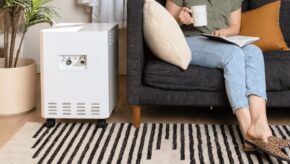The growth of mold has begun inside of your home, leaving your walls discolored, a musty odor permeating within your home, and in some cases it can even lead to an exacerbation of adverse health effects to those occupants exposed to the mold in their homes. The list of problems within a home that is experiencing mold growth can be insurmountable, but the real challenges will really begin during the process of trying to kill and remove the mold from within your home and doing so effectively and safely.
There are many different methods that can be implemented into a home to aid in the eradication and mitigation of mold growth inside your indoor environment, with the most popular solution being with the assistance of a mold remediation specialist that is trained in the mold removal process. These mold remediation specialists will work to kill and remove mold that is contained on the surfaces of your home. However, when it comes to those airborne mold spores in the air you will need an additional source of mitigation, such as from the use of a highly-effective mold air purifier in your home.
In this article we are going to discuss the threats posed by mold and its spores in your home, and what type of air purifier is best to use in a home to aid in the containment and killing of mold spores from the air.
What is Mold in House?
Mold is a one-syllable word that can strike fear into most homeowners, as the thoughts and dangers will begin to circulate within their heads of the potential hazards this fungus can create within the confines of their indoor home environment. This type of household fungus can grow rapidly in most environments where ideal conditions are met that will further exacerbate the growth of this potentially dangerous fungi. Depending on the mold classification found in your home, the effects that it can produce in the environment can vary, as there are over hundreds of thousands of different mold species found throughout the world today – with many still unidentified.
The development of mold in a home will begin in most cases with moisture intrusions or leaks that will present an ideal condition for mold growth to form, and if you add moisture with warmer climates and a deprivation of light in the environment mold will flourish rapidly. As the mold begins to grow and spread in the home it can begin to weaken walls, ceilings, and floors and eventually ruin these surfaces, as it begins to eat the material of these surfaces. Additionally, the mold will start emitting mold spores into the air of the home that will float and land on surfaces of the home to reproduce and create more mold. However, these traveling airborne mold spores can be potentially hazardous to human health as they can enter into the body through inhalation/ingestion making its ways into the deepest recesses of the lungs and possibly triggering severe health effects in some individuals.
Types of Household Mold
Did you know that according to a 2003 University of Arizona study they found that 100 percent of homes have mold? Although this study does not classify the types of molds found in homes, as there are many classifications of mold that are not hazardous, some molds like stachybotrys chartarum is dangerous and a mold that can wreak havoc in a home – and most importantly on the occupants exposed to this type of mold. A specific mold species will have its own characteristics, growth patterns, and effects on human health when growing in an indoor environment, and each of these variations can help in the identification process of the types of household mold allowing you to identify different types of mold in house. However, when it comes to identifying mold types that are known to grow in homes, these types listed below are the most commonly seen and observed.
- Alternaria: A commonly known allergenic mold, Alternaria is a velvet textured mold that usually appears as dark green or brown on surfaces. Where moisture is present this mold will typically grow – found near showers, bathtubs, and even below leaking sinks.
- Aspergillus: A household mold that has long flask-shaped spores that can develop in thick layers on the walls. This allergenic mold is capable of being a more toxic type of mold depending on the species and the environment that the mold is affecting.
- Cladosporium: Another form of allergenic mold, Cladosporium is a versatile mold that can grow in both indoor and outdoor conditions where fabric is found like carpeting, fabrics, and upholstery. This type of mold has an olive-green or brown appearance that is also suede-like in texture.
- Penicillin: Penicillin is recognizable by its blue or green colored surface with a velvety texture that is often found in water-damaged homes and building. This type of mold spreads quickly in the environment, and is mostly found in carpets, wallpapers, ducting, and even in mattresses.
- Stachybotrys: Is black mold dangerous? One of the most toxic forms of mold known to most people, Stachybotrys Chartarum is a toxigenic mold that is known to cause allergic reactions in individuals exposed to this form of mold. This mold is identified by its dark coloring, usually dark greenish or black on the surfaces in which it is growing on in an indoor environment. Stachybotrys releases mycotoxins into the environment which is known to cause severe health problems in those who are exposed to them in the air.
How Does Mold Reproduce
During the process where mold is developing in an environment, once it reaches a certain stage of this growth process it will begin to release and produce spores into the air that are known as mold spores. Mold spores are the reproductive seeds of mold that are emitted into the air in the pursuit to form and grow more mold in the environment. When these mold spores are released into the air it increases the chances that these spores can enter into the human body and reach into the lungs and eventually into the bloodstream, which can be very dangerous.
When an individual inhales mold spores into the body it can spark an allergic response in most people since the immune system is usually triggered by these spores. The immune system is a reactive function in the human body that works by fighting off foreign invaders that enter into the body that the immune system will trigger responses such as those like allergy symptoms. The allergic responses include sneezing, runny noses, red eyes, and even skin rashes in some cases according to the EPA.
What is an Ozone Machine
When mold forms and spreads inside of a home it can taint both the indoor air quality and human health to those that are exposed to the mold-impacted environment. If you have identified that there is mold presence, either significant or acute in your home, it may be necessary to turn to forms of mitigation to remove this mold from the environment both safely and effectively. One method that is commonly being used for mold removal in the air of your home is the use of air purification or air purifier devices to filter the air of mold spores that may be present and remove them from the air you breathe in this environment. There are a variety of different air purifier solutions that can be placed and utilized within an environment where indoor mold growth is present such as that of an ozone machine.
An ozone generator or machine is an air purifier that is used in different indoor environments such as those with mold growth to aid in the mitigation and removal of the mold spores from the air of the space. However, when it comes to the use of these air purifiers in an indoor environment, they can potentially create more danger and hazards than it can to improve the environment and remove toxic pollutants from the air. This type of air purifier produces ozone into the air, ozone is a tiny molecule that is composed of three oxygen atoms that can be highly reactive and unstable when in the environment.
How Does an Ozone Generator Work
How does an ozone machine work? The functions and mechanisms in which an ozone generator works is different to that of other air purifiers. These devices work by producing ozone gas into the air, these ozone molecules are constructed of oxygen (O2) molecules into single atoms, which will then attach to other oxygen molecules in the air to form ozone (O3). The O3 molecules that are released into the air from the ozone machine will work aggressively through oxidation to attach to airborne pollutants in the air. This happens when the third oxygen atom detaches from the ozone to attach to other substances in the air to alter its chemical composition.
When the ozone is emitted into the air by the ozone generator or machine it will help to address and eliminate airborne pollutants including odors and mold/mildew contaminants that can taint the air quality. However, due to the elevated levels of ozone gas that is emitted into the air it can lead to certain health reactions and effects if and when significant exposure occurs in the indoor environment.
Are Ozone Generators Safe?
There have been major debates over the safety and health of ozone generators, particularly when used in an indoor environment like a home or office building where occupants are present. The ozone that is released from ozone generators are usually produced in high concentrations which can react with the human body adversely. According to the Environmental Protection Agency (EPA) stated the following in regard to ozone generators;
“When [ozone] is inhaled into the human body, it can damage the lungs. Relatively low amounts can cause chest pain, coughing, shortness of breath and throat irritation. Additionally, ozone may also worsen chronic respiratory diseases such as asthma and compromise the ability to fight respiratory infections.”
Will Ozone Kill Mold in the Air
Does an ozone generator kill mold? As we learned above, ozone generators or machines use and produce ozone into the environment to work to remove pollutants that may be trapped within the air of your indoor environment such as mold spores and other organic matter. Mold is a fungus, or organic matter that can be impacted by the emission of ozone gas into the air. The ozone will aggressively work to attach to these mold spores in the air to remove them from the airspace, which is why many people will select this form of air purification for their home’s with mold growth present indoors. The composition of ozone is formed of three oxygen molecules, which allows for the molecules to combine itself with mold spores in the air and change them in a way that will destroy the cells that compose the mold spore size.
Although the ozone generator mold removal process can be a way to kill mold spores in the air, it can additionally result in the emission of potentially dangerous gases into the air that may result in adverse health effects. This can leave the environment just as tainted, if not more by the high levels of ozone in the air, therefore making it a less desirable option for mold removal in the air.
Alternative Air Purifier for Mold
When it comes to selecting an air purifier to remove airborne mold spores from the air of a home that has been tainted by indoor mold growth, there are many factors that need to be considered prior to purchasing. First, it is important to look for an air purifier that has the killing capability to destroy mold spores that are filtered through the device, typically this done through the use of UV-C lights. Secondly, you will need a high-efficiency filter that is capable of capturing fine particulate matter such as mold spores into the filter media. Lastly, you will want to find an air purifier technology that does not release or produce byproducts or chemicals into the air that can potentially compromise the air quality and human health more than it already is from the indoor mold presence.
The EnviroKlenz UV Air Purifier is an effective air purifier that combines Advanced EnviroKlenz technology for toxic and noxious chemical and odor removal with HEPA filtration and ultraviolet germicidal radiation (UVC) to remove airborne particulates and allergens and inhibit the growth of captured microorganisms including mold spores, bacteria, and viruses. The design of the EnviroKlenz UV Air Purifier allows the filtration device the capability for toxic VOCs to be neutralized that may be produced from the mold and its spores, while also containing a hospital-grade HEPA filter for the ability to capture those fine particulate matter than are larger than 0.3 microns in size from the air, this will include those microscopic reproductive spores emitted from mold. As the mold spores become collected on the collection media of the HEPA filter, positioned above this filter are two UV-C lights that are safely within the safe wavelength levels that won’t produce ozone but will have the capability of shining on microorganisms like mold spores to destroy them on the collection surface. Therefore, allowing the EnviroKlenz Air Purifier to be both a safe and effective solution for airborne mold spore removal in a home where mold has been found growing and thriving.
Article Sources:
- WebMD: What is Mold? (link)
- U.S. News & World Report: What to Do If Your House Has Mold (Or You Think It Does) (link)
- Environmental Protection Agency (EPA): A Brief Guide to Mold, Moisture, and Your Home (link)
- Environmental Protection Agency (EPA): Ozone Generators That are Sold as Air Cleaners (link)
EnviroKlenz® Medical Disclaimer:
“Any information that is provided on this website is not for the use by any commercial or personal entity without expressed written consent of the blog author. The material and statements illustrated within this blog are not intended to diagnose, treat, cure, or prevent any diseases or medical conditions. Nor does the author in any way guarantee or validate the validity, totality, or efficacy of any claims and will therefore not be held responsible for the content of any claims. Always consult your medical physician for any specific medical advice or recommendations.”








